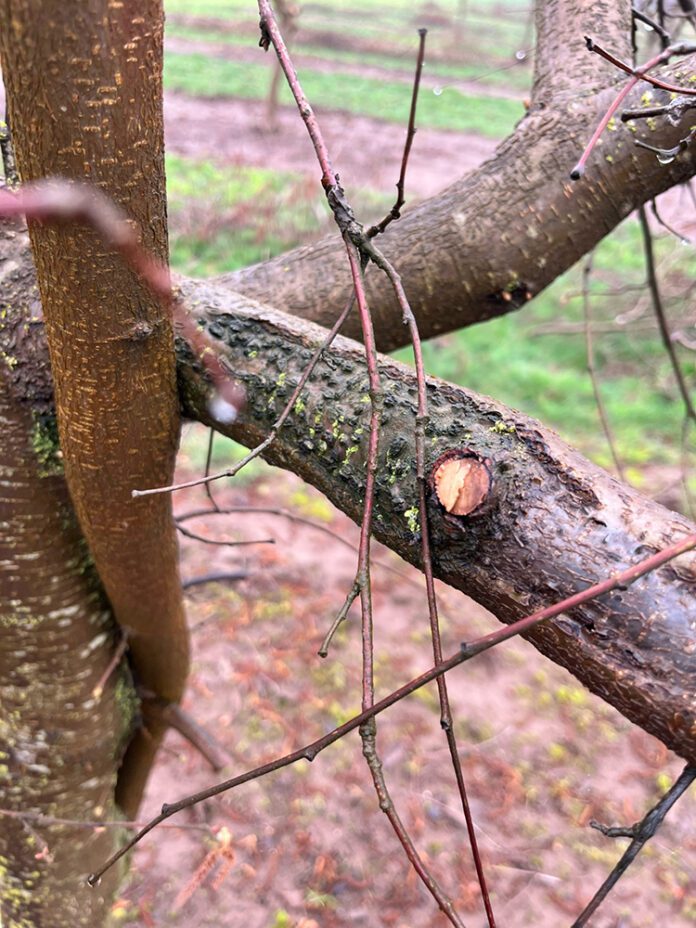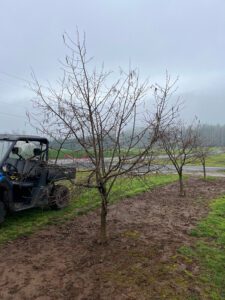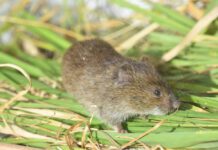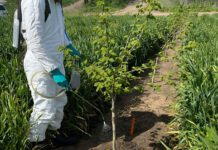
In winter 2021-22, when a hazelnut grower near Woodburn, Ore. alerted Oregon State University (OSU) Extension Orchard Specialist Nik Wiman to a large number of cankers in an orchard planted to the Eastern Filbert Blight-resistant variety Jefferson, Wiman wasn’t too concerned. After all, it wasn’t unusual for minor expressions of Eastern Filbert Blight (EFB) to appear on resistant trees. But in the past, the cankers were small and would soon dissipate as the EFB fungus was unable to complete its life cycle.
In this case, however, Wiman said the cankers weren’t typical of ones that researchers had formerly seen on resistant cultivars.
“These cankers looked like normal, everyday healthy cankers,” said OSU Plant Pathologist Jay Pscheidt, who also viewed the orchard. “Something was seriously wrong.”
What was wrong, and what is now clear, is there is a new strain of EFB in the Willamette Valley, one that is able to overcome the resistance conferred by the Gasaway gene, which the OSU Hazelnut Breeding Program bred into several varieties now widely planted in Oregon, including Jefferson.
What was unknown at that time is where the new strain originated. Researchers were unsure whether it was a strain from back East, where strains of EFB have long shown the ability to overcome the Gasaway gene, or was it homegrown, a mutation of the original Oregon EFB strain. Since then, by comparing the DNA fingerprint of the new strain with strains from back East and with the original Oregon EFB strain, researchers have largely determined it is homegrown.
“It is pretty strong evidence that it is homegrown,” said Ken Johnson, a professor in the Dept. of Botany and Plant Pathology at OSU. Johnson, with the help of a graduate student, Kameron Kilday, found the new strain directly matches the DNA fingerprint of the original Oregon EFB strain and does not match any of the strains they tested from back East.
Also, Johnson said, logic tells researchers the strain is homegrown, given it was originally found in the middle of the 60-acre Jefferson orchard, not on an outer row.
“It doesn’t really fit the story that it came from somewhere else,” Johnson said of the discovery.

Johnson added at this point, researchers are unable to say how virulent the new strain is, but they suspect it will be similar to the old strain, in particular to the old strain’s virulence on Barcelona. “That’s the best ballpark guess we have at this point,” Johnson said.
Moving Through the Valley
Another question researchers have at this point is how the new strain is moving through the valley. The strain has popped up at isolated sites many miles from the original hotspot and is not necessarily spreading out in a concentric fashion from where it was first discovered.
Alex Duerst, hazelnut production manager at Silverton-based Ioka Farms, for example, recently found EFB infection on a McDonald tree, one of the several OSU cultivars released by the OSU Hazelnut Breeding Program that has the Gasaway gene. How the new strain got from the hotspot to the Silverton hills is a question that puzzles researchers.
“That is one of those outlying cases that is kind of mysterious,” Wiman said. “I would think he has got to have a neighbor around there somewhere that has some infection on resistant varieties for a mature tree like that to have the look of what we’re seeing in sort of the ground zero area.”
Adding to the mystery, Duerst noted the farm found the infection on just one tree in the 80-acre orchard that the farm planted to the McDonald variety over a three-year period beginning in 2016.
“We pruned the entire block, so they put their eyes on every tree, and they found one that was infected,” he said. The tree, which was on an outside row, had to be taken out, Duerst added, because the canker was in the crotch of the tree.
Duerst now wonders whether other trees in the orchard are infected, particularly given that EFB symptoms don’t show up for a year to 18 months after infection.
Duerst added the farm, which is a leading producer of grass seed, is considering planting another 30-acre block to the tree nut, but he is wondering now whether it would be wise to wait for the Breeding Program to release a new variety with resistance to the new strain, of which there are several in the pipeline. Then again, Duerst wonders if it is worth waiting, given the EFB fungus was able to overcome the Gasaway gene resistance in 15 years, and it may just be a matter of time before resistance breaks down again in the next cultivar, a concern Wiman said is reasonable.
“Many crops are that way,” Wiman said. “A resistant variety comes out, and nature finds a way to overcome that resistance. There is a biological arms race going on between the plant and the disease.”
While researchers don’t know exactly how resistance broke down in the Gasaway cultivars, they suspect it can be traced to the extensive amount of disease pressure placed on the cultivars since they came out in the late aughts. With some exceptions, growers were not spraying for EFB in the resistant cultivars, or at most spraying once a year, and growers often had susceptible cultivars planted adjacent to resistant cultivars. At times, growers even planted susceptible trees amongst resistant cultivars, Pscheidt said.
“We were putting a lot of disease pressure on the resistance gene,” Wiman said.
Growers Need to Act
At this point, regardless of where the new strain originated, why resistance has broken down or how the new strain is moving around the valley, researchers say growers need to act.
“All the growers need to take action on this thing,” Pscheidt said. “Based on the history of how this thing has moved and our inability to know exactly where it’s going to go next, I’m putting the warning out to all growers, whether you have susceptible cultivars or resistant cultivars, that the risk is out there and we need to implement the full management program, which includes scouting, and if you find it, remove it by pruning, and then implementing a fungicide protection program.”
“This really sets us back in terms of our sustainability goals,” Wiman said, “but we have to rely a little more on fungicides now than in the past. Overall, it is just something we have to adapt to.”
The current OSU recommendation is to apply four fungicide treatments two weeks apart beginning at budbreak.
The good news for many of the older growers in the valley is they have dealt with EFB in the past and are familiar with management strategies. For many growers relatively new to the crop, however, many of whom have only worked with resistant varieties, this is a whole new ballgame, Wiman said.
“Jay and I had a workshop recently for growers who have recently joined the industry that don’t have historic perspective and don’t have experience with Eastern Filbert Blight,” Wiman said. “And we are encouraging the new growers to seek guidance from the elder growers in our community.
“It is intimidating if you’ve never dealt with EFB before and you never thought you were going to have to confront it,” he added. “But they need to get on board with this [management program]. They may not realize how devastating it can be.”















